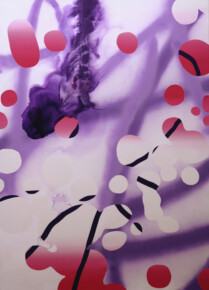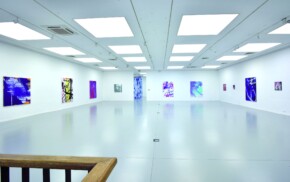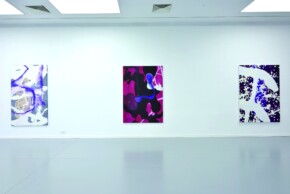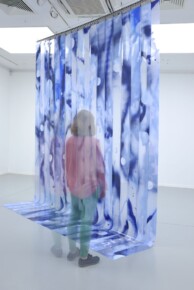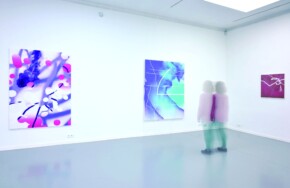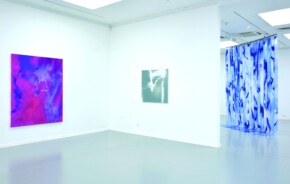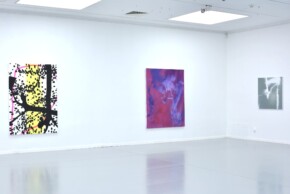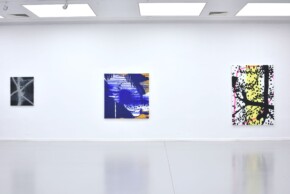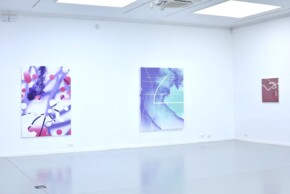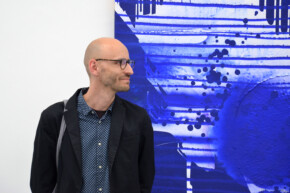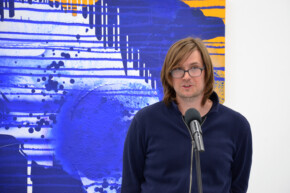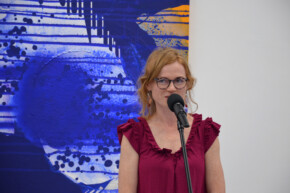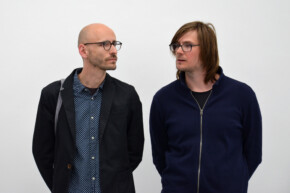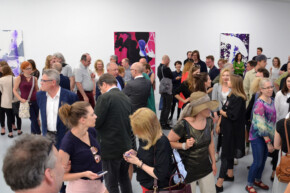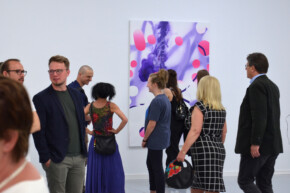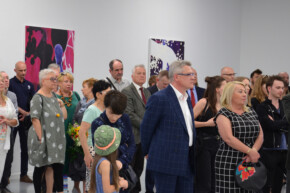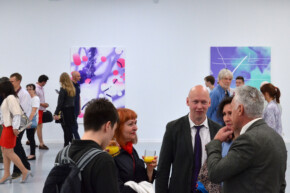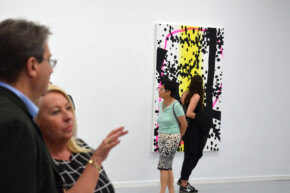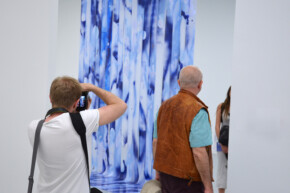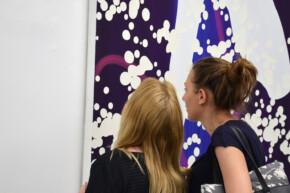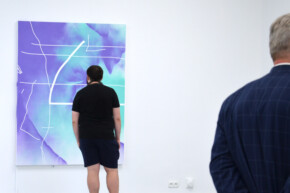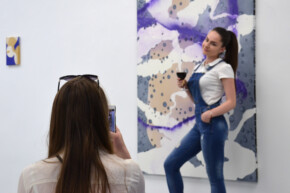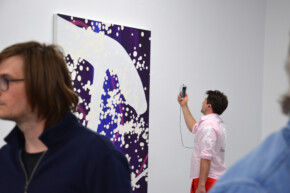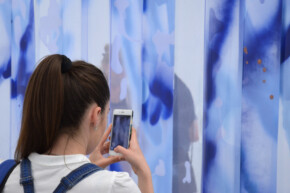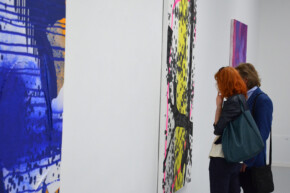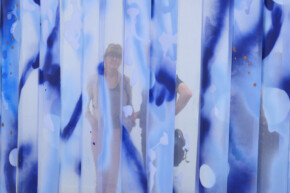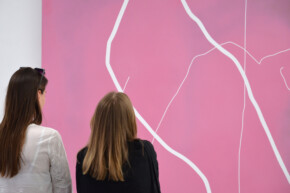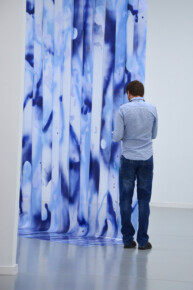Sebastian Krzywak was born in 1979 in Zielona Góra. He studied painting at the Academy of Fine Arts in Poznań. In 2004/2005, scholarship holder of the BZ WBK bank; winner of the Salted Candy competition in 2009. Since 2015, he has been an assistant at the First Painting Studio of Professor Andrzej Lesnik at the Interdisciplinary Faculty at the Department of Art Education and Curatorship of Art University in Poznan; he cooperates with School of Form in Poznan / Poland. He presented his works, among others, at Nowa Gallery, Starter, Rotunda, ON and Rodriguez in Poznań, Leto Gallery and the Stefan Gierowski Foundation in Warsaw, PWW Gallery in Zielona Góra, MBWA in Leszno, Water Tower in Konin, BWA and UP in Piła, BWA in Bielsko-Biała, the Pomeranian Dukes’ Castle in Szczecin, the Wozownia Gallery in Toruń and Kulturbrauerei in Berlin, as well as in non-institutional spaces. Lives and works in Poznań.
“When somewhere around 2001 I started getting to know graphic design software, being completely unaware of this area, I asked my more experienced colleague about the difference between Corel that was popular at that time, and Photoshop. I heard an enigmatic sentence then, which of course I didn’t understand, but I nodded my head in agreement: In Corel, you work with curves, and in Photoshop – with layers. Later on I realized that this sentence, as well as the contact with new imaging tools, somehow shaped my views, or systematised what I already intuitively perceived. I have translated this way of seeing into reality. The world of curves was a world of dimensions and angles, points of convergence, figures and fillings. The space of layers, on the other hand, was more ambiguous, the contours were blurring, or there were no contours at all, thus the shapes became illegible. In addition, the subsequent arrangements could permeate each other. All this created a completely new, disturbing and unlimited quality, closer to the way I felt the reality at the time. I even believed there were people who saw the world in curves and there were people who saw the world through layers.
The moment of contact with a different visuality is the moment of changes in vision. Art has been transformed in the same way, an area so dependent on the eye, on what and how we see. The images take a special place here, the history of painting is the history of constant expansion of various forms of seeing, reflecting how the reality itself has been changing. The title of the exhibition – Flatten Image – was taken from Photoshop by no accident. Sebastian Krzywak’s works naturally reflect solutions coming from digital reality, inspired more or less consciously by the way tools work in graphic programs. And even if paint still remains paint, then the content of an image, its components such as colour, form or depth, are soaked with the logic that Photoshop offers us. One can notice the traces of such tools as eraser tool, air brush, drop shadow; there is also a distinctive template. We can therefore look at these works as examples of post-analogue painting, where the motifs and solutions typical of digital aesthetics become components of the new visuality. On the other hand, for Krzywak, who was born in the late 1970s, there is nothing obvious. It’s because he belongs to the generation that spent their childhood in the analogue age, and entered the digital one already with a certain awareness. This results in a specific mix of delight and distrust at the same time. In this sense, Krzywak’s painting is not only a neat imitation of digital aesthetics, but rather an attempt to give it the materiality that we face in the real world. Paints remain paints, but with all their properties and consequences. The works are rotated, subjected to gravitational forces, and time is also important. On the one hand, we have the transparency, to have density and weight on the other hand. The effects are not to be painted, they are to be created on their own by the process that takes place between different types of paints. Subsequent layers do merge, but not as much as they would merge in a graphics program. In this, there is an element of directness, readiness and openness to those moments when something has clearly gone wrong. It is a combination of both giving up on and controlling the process, which in this case seems to be marked by some primordial human energy. If the imaging tools we find in the graphics programs were to imitate the mechanisms we know from the real world, then Krzywak’s painting converts the aesthetics they offer us back to the analogue language. The result is surprising because what we get at the end is no longer one or the other. Reality is rebuilt, but in trust in what is inevitable and unpredictable.
Let’s come back to the title of the exhibition. Flatten image is a Photoshop command that allows us to merge all the visible layers we worked on into one image. This is called flattening. The decision to do so is usually final to some extent, because after saving the file we will no longer be able to view and edit individual layers. We can only overlay more In this context, Krzywak’s works – based actually on the process of arranging successive layers, covering them up and over-painting them, sometimes only to reveal them in a different way – direct our thoughts towards the way an image or reality is built, the way we see it. When we talk about a flattened image of reality, we usually mean a judgement that is somewhat lacking, incomplete, and often unjust in relation to the thing we are talking about. It is simply a result of not perceiving other levels of a phenomenon. So the property attributed to a graphics program and transferred to painting reveals an interesting paradox for us. What we get, after all, is always a flattened image, but only flattening allows us to see the elements that make up the image. In the works by Sebastian Krzywak the process of creating images reflects the process of shaping reality. There is nothing that would remain indifferent. Everything remains in relation, even if there was no intention to do so in the first place. And it doesn’t matter whether each of these layers is good or whether each of them is able to satisfy us in the same way visually. I don’t think so. And here we come to another paradox, that it is only the sum of layers that matters, i.e. the flattened image. How much of a given visuality we are able to read depends actually only on us. This requires continuous practice. Art in this sense can become a kind of school of looking, of acquiring the ability to see the whole and to go into the components at the same time. The visual layer is always more convincing than any text. Only those things exist which we can see for ourselves. This gives practically unlimited possibilities of intuitive searching for meanings. The process of creating an image actually never ends. It is the audience who adds the subsequent layers.”
przemek s.
Przemek Sowiński – curator, artist, graduate of Art Education at the Adam Mickiewicz University. Founder of the Łęctwo gallery. Author of such exhibitions as Nothing Will Ever Come Out of This (Łęctwo, 2016), Eyes in Concrete (Łęctwo, 2017), or Oh, These Poznan Vernissages (Łęctwo, 2017). Cooperated with the Malta Festival Poznań, Poznań Art Week, Zona Sztuki Aktualnej in Szczecin and the Centre of Modern Art “Zamek Ujazdowski” in Warsaw. Lover of physical labour. Hates writing and speaking in public.
open 08.05.5018 (Tuesday) 6 pm
end 03.06.2018
Curator: Przemek Sowiński
Cooperation: Danka Milewska


